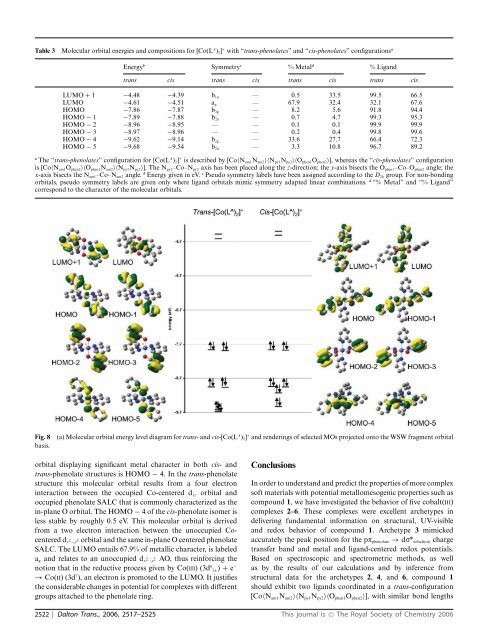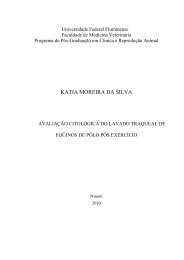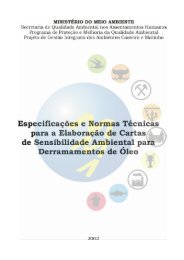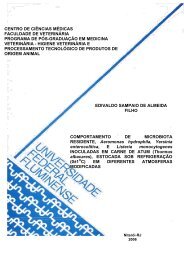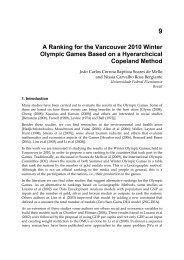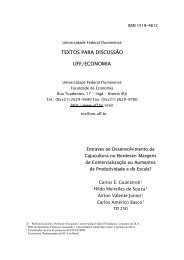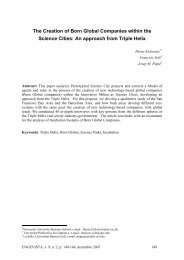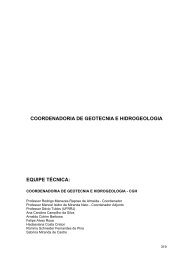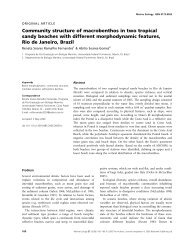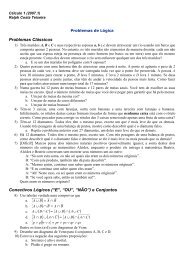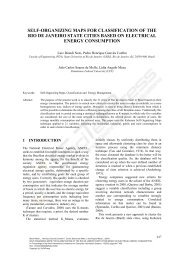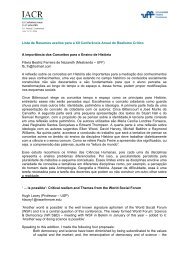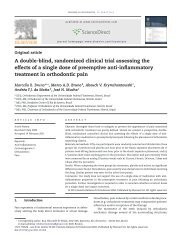Structural, spectroscopic, and electrochemical behavior of trans - UFF
Structural, spectroscopic, and electrochemical behavior of trans - UFF
Structural, spectroscopic, and electrochemical behavior of trans - UFF
You also want an ePaper? Increase the reach of your titles
YUMPU automatically turns print PDFs into web optimized ePapers that Google loves.
Table 3<br />
Molecular orbital energies <strong>and</strong> compositions for [Co(L A ) 2 ] + with “<strong>trans</strong>-phenolates”<strong>and</strong>“cis-phenolates” configurations a<br />
Energy b Symmetry c %Metal d % Lig<strong>and</strong><br />
<strong>trans</strong> cis <strong>trans</strong> cis <strong>trans</strong> cis <strong>trans</strong> cis<br />
LUMO + 1 −4.48 −4.39 b 1u — 0.5 33.5 99.5 66.5<br />
LUMO −4.61 −4.51 a g — 67.9 32.4 32.1 67.6<br />
HOMO −7.86 −7.87 b 3g — 8.2 5.6 91.8 94.4<br />
HOMO − 1 −7.89 −7.88 b 2u — 0.7 4.7 99.3 95.3<br />
HOMO − 2 −8.96 −8.95 — — 0.1 0.1 99.9 99.9<br />
HOMO − 3 −8.97 −8.96 — — 0.2 0.4 99.8 99.6<br />
HOMO − 4 −9.62 −9.14 b 2g — 33.6 27.7 66.4 72.3<br />
HOMO − 5 −9.68 −9.54 b 2u — 3.3 10.8 96.7 89.2<br />
a<br />
The “<strong>trans</strong>-phenolates” configuration for [Co(L A ) 2 ] + is described by [Co〈N am1 N am2 〉〈N py1 N py2 〉〈O phen1 O phen2 〉], whereas the “cis-phenolates” configuration<br />
is [Co〈N am1 O phen2 〉〈O phen1 N am2 〉〈N py1 N py2 〉]. The N py1 –Co–N py2 axis has been placed along the z-direction; the y-axis bisects the O phen1 –Co–O phen2 angle; the<br />
x-axis bisects the N am1 –Co–N am2 angle. b Energy given in eV. c Pseudo symmetry labels have been assigned according to the D 2h group. For non-bonding<br />
orbitals, pseudo symmetry labels are given only where lig<strong>and</strong> orbitals mimic symmetry adapted linear combinations. d “% Metal” <strong>and</strong> “% Lig<strong>and</strong>”<br />
correspond to the character <strong>of</strong> the molecular orbitals.<br />
Fig. 8<br />
basis.<br />
(a) Molecular orbital energy level diagram for <strong>trans</strong>-<strong>and</strong>cis-[Co(L A ) 2 ] + <strong>and</strong> renderings <strong>of</strong> selected MOs projected onto the WSW fragment orbital<br />
orbital displaying significant metal character in both cis- <strong>and</strong><br />
<strong>trans</strong>-phenolate structures is HOMO − 4. In the <strong>trans</strong>-phenolate<br />
structure this molecular orbital results from a four electron<br />
interaction between the occupied Co-centered d xz orbital <strong>and</strong><br />
occupied phenolate SALC that is commonly characterized as the<br />
in-plane O orbital. The HOMO − 4<strong>of</strong>thecis-phenolate isomer is<br />
less stable by roughly 0.5 eV. This molecular orbital is derived<br />
from a two electron interaction between the unoccupied Cocentered<br />
d x 2 −y 2 orbital <strong>and</strong> the same in-plane O centered phenolate<br />
SALC. The LUMO entails 67.9% <strong>of</strong> metallic character, is labeled<br />
a g <strong>and</strong> relates to an unoccupied d x 2 −y 2 AO, thus reinforcing the<br />
notion that in the reductive process given by Co(III) (3d 6 l.s.) + e −<br />
→ Co(II) (3d 7 ), an electron is promoted to the LUMO. It justifies<br />
the considerable changes in potential for complexes with different<br />
groups attached to the phenolate ring.<br />
Conclusions<br />
In order to underst<strong>and</strong> <strong>and</strong> predict the properties <strong>of</strong> more complex<br />
s<strong>of</strong>t materials with potential metallomesogenic properties such as<br />
compound 1, we have investigated the <strong>behavior</strong> <strong>of</strong> five cobalt(III)<br />
complexes 2–6. These complexes were excellent archetypes in<br />
delivering fundamental information on structural, UV-visible<br />
<strong>and</strong> redox <strong>behavior</strong> <strong>of</strong> compound 1. Archetype 3 mimicked<br />
accurately the peak position for the pp phenolate → dr* cobalt(III) charge<br />
<strong>trans</strong>fer b<strong>and</strong> <strong>and</strong> metal <strong>and</strong> lig<strong>and</strong>-centered redox potentials.<br />
Based on <strong>spectroscopic</strong> <strong>and</strong> spectrometric methods, as well<br />
as by the results <strong>of</strong> our calculations <strong>and</strong> by inference from<br />
structural data for the archetypes 2, 4, <strong>and</strong> 6, compound 1<br />
should exhibit two lig<strong>and</strong>s coordinated in a <strong>trans</strong>-configuration<br />
[Co〈N am1 N am2 〉〈N py1 N py2 〉〈O phen1 O phen2 〉], with similar bond lengths<br />
2522 | Dalton Trans., 2006, 2517–2525 This journal is © The Royal Society <strong>of</strong> Chemistry 2006


